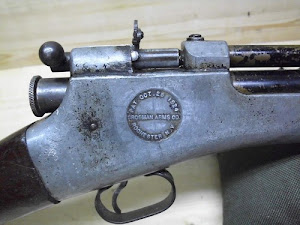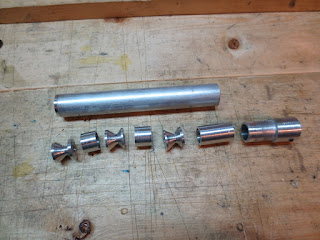With everything cleaned up and checked out it is time to put the 707 back together. First up is putting the barrel back in and aligning all the holes. The bushing is a slip fit on the barrel and helps hold the barrel centered in the tube.
This bushing sitting on top of the tube is for the tap detent it also helps hold the barrel in place.
With the barrel held in place by the detent bushing I installed the hammer/ transfer port, spring and bolt handle. The L shaped slot in the tube is for the bolt handle, the bolt is also the safety. With the bolt cocked it can be rotated up locking the bolt in the cocked position and the gun wont fire until the bolt handle is rotated down.
Here the tap, detent ball and spring and knob are laid out and ready to be installed.
With the tap installed I was ready to install the valve. The bolt at the top serves two purposes it locates the barrel in the tube and also locates the stock in the proper spot.
I used a socket slightly smaller in diameter than the valve and a wooden dowel to push the valve with its new O-ring into position. It was a bit tricky getting the transfer port to slip inside the valve and the threaded hole in the valve needs to be aligned with the hole in the tube for the screw to lock it in place.
A close up of the low tech mount, AKA a hose clamp. The front clamp also compresses the tube around the bushing that aligns the barrel with the tube.
I slipped the mounting clamps over the tube and laid the whole assembly in the stock. Two screws mount this assembly to the stock, the rear screw in the trigger guard and a screw in the fore stock.
The final pieces, front and rear sights along with the piercing cap were installed. I put in a CO2 cartridge to check for leaks and it's holding gas!
No "Soda straw" barrel on this shooter, the OD on this solid barrel is 1/2".
Once I was sure it was going to hold gas I shot a ten shot group with RWS Hobby pellets to foul the freshly scrubbed bore.
The top bullseye are the last 25 shots I fired before the tear down. The bottom bullseye are the first ten shots after the reassembly.
I switched to one of my favorite pellets, RWS Meisterkugeln in 7 grain to get the rifle sighted in again. Once it was sighted in I took my time and shot this 10 shot group. Things are looking good! 10 shots inside a dime at ten yards. I finished off the CO2 cartridge after shooting this target and got another ten shots for a total of 40 shots from a 12 gram cartridge.
I am very pleased with this shooter, it is as accurate as I was hoping for. I really like how easy it is to load pellets, no fumbling around to get the pellets into the breech on this air gun.
I don't think it shows in the pictures but there is quite a bit of rust pitting on the tube and barrel, I may tear it down later and remove the pitting and reblue all the metal. It would be a good winter project...




























